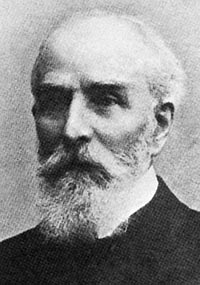
Wilhelm Kreß (Kress) (1836 - 1913)
October 1901, Austrian Wilhelm Kress begins trials with his tandem three-winged seaplane. It eventually achieves the first hop from water before capsizing. Fitted with a 30hp (22.4kW) Daimler engine, it is the first ever piloted aero plain to use a petrol internal combustion engine.
The Wilhelm Kreß (Kress) Aeroplane Scientific American, 84, March 2, 1901, p. 137 The most recent attempt to solve the problem of artificial flight has been made by W. Kress, a German engineer, who for twenty years has patiently labored on an aeroplane in which he has embodied his ideas.
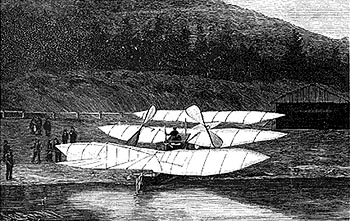 The Wilhelm Kreß (Kress) Aeroplane Lithograph, Scientific American, 84, March 2, 1901, p. 137 http://invention.psychology.msstate.edu
The Kress aeroplane consists of an ice-boat having two keels and a long stem. The keels serve as runners when the machine is traveling over ice or snow. Two resilient sail-propellers, rotated by a benzin-motor in opposite directions, drive the apparatus. Above the boat, arched sails, constituting resistant kite surfaces, are carried, one sail being mounted somewhat above the other, so that it will receive an impinging body of air without interference from the other sails. The aeroplane thus constituted is guided by a horizontal and a vertical rudder, both of which, however, are used only in flying.
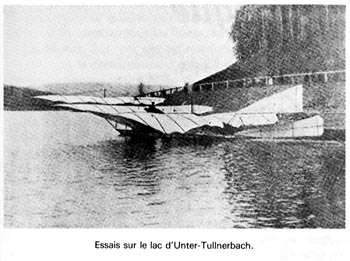 The Wilhelm Kreß (Kress) Aeroplane Contemporary photo taken at the time
Owing to lack of funds the inventor could not equip his air-ship with a benzin-motor of the special construction and power desired, and was therefore compelled to use an ordinary automobile-motor. Thus fitted out the aeroplane was first tried on water. For it is Mr. Kress' opinion that water-trials should first be made in order to ascertain whether the motor, propellers, rudders, and other parts have been properly arranged and are trustworthy and perfectly efficient in operation.
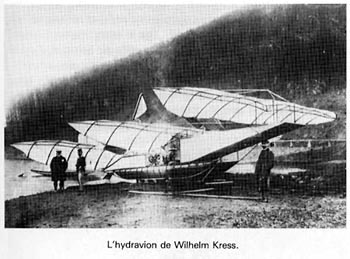 The Wilhelm Kreß (Kress) Aeroplane Contemporary photo taken at the time
Only when the safety of the machine has thus been proven should aerial flights be taken. The sense of security obtained by numerous water-trials and the increased speed attained with each trial will finally give to the aeronaut that confidence which will enable him to soar aloft. That moment, according to Mr. Kress, may come unawares; the ship may of its own accord leave the surface of the water.
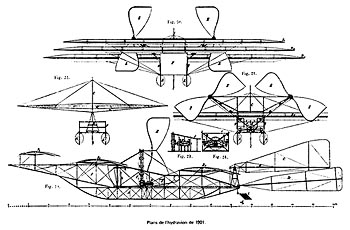 The Wilhelm Kreß (Kress) Aeroplane Download a 1000pixel image
So far as the preliminary water-trials are concerned, the Kress aeroplane seems to have met its inventor's expectations. In the presence of an officer of the aeronautical division of the German army, the flying-machine was taken from its housing and carted to a nearby lake. Kress seated himself in the boat and pulled the starting lever. The propellers drove the machine along at a uniform speed, according to the accounts which have been received.
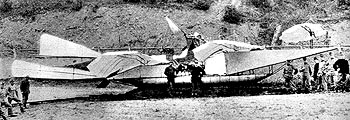 The Wilhelm Kreß (Kress) Aeroplane Download a 1000pixel image
In order to test the maneuvering power of the contrivance Kress is said to have performed various evolutions and to have succeeded even in making headway against the wind. The steering apparatus seems to have acted efficiently. The motor, however, proved inadequate. With a motor of less weight and greater horse power the inventor believes that his flying-machine would be an assured success. Lack of funds may prevent him from carrying out his plan with an improved motor.
Wilhelm Kreß (Kress) 1901: Der Drachenflieger des österreichischen Flugpioniers und Erfinders der Knüppelsteuerung, Wilhelm Kress, wird bei dem heute stattfindenden ersten (und einzigen) Flugversuch von Seitenwind erfasst, kippt und versinkt in den Fluten des Tullnerbacher Stausees.
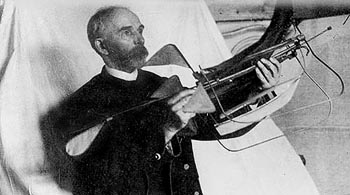 The Wilhelm Kreß (Kress), 1900
Trotzdem ist der Erfinder überzeugt, dass "doch das Luftautomobil das idealste und beliebteste Verkehrsmittel der Zukunft" werden wird. Trotz seiner 65 Jahre würde Kress selbst lieber weitere Flugversuche unternehmen, "als dass ich in einem Automobil Platz nehmen sollte, wo der Chauffeur die Absicht hätte, mit 80 bis 100 km die Stunde auf der Landstrasse dahinzusausen."
Kreß, Wilhelm, * 29. 7. 1836 St. Petersburg (RUS), Ü 24. 2. 1913 Wien, Flugpionier, Konstrukteur. Kam 1873 nach Wien, wo er 1877 das erste frei schwebende Drachenfliegermodell zum Fliegen brachte. Der Start eines ersten Motorflugzeugs auf dem Wienerwaldstausee misslang 1901 wegen eines zu schweren Motors. 2 Jahre später gelang in den USA den Brüdern Wright der erste Motorflug. K. erfand um 1900 den "Steuerknüppel" zur kombinierten Steuerung.
Connections
On the Ball : Osborne Reynolds : Wilhelm Kress If something slipped, slid or flowed in the late 19th century, Osborne Reynolds did the numbers on it. He was the man who came up with the idea that depending on your design, there was a critical velocity at which the airflow over your wing would become so turbulent you would start to fly like a brick. Reynolds produced a formula that pulled together all the relevant factors involved in avoiding such an aerodynamic anathema when you were building your flying machine. This was all theoretical, because nobody had actually flown at the time, but it became instantly practical at Kitty Hawk. Which was where the assiduous study of Reynolds numbers saved the Wrights from a nosedive into the sand. (Funnily enough, the Wrights were also into ball bearings; their day job involved running a bicycle shop.) Mind you, I wouldn't even be mentioning the Wright brothers at all had life not dealt a lousy hand, two years earlier, to one of those individuals whose name might have become a household word but didn't: Wilhelm Kress. Alas for Wilhelm, you won't find him in the Aeronautics Hall of Fame. Kress was a piano maker turned engineer, and in October 1901 the 68-year-old wannabe from Austria (his emperor was offering a big prize for the first powered flight) opened the throttle on his three-winged floatplane and accelerated out across the surface of a reservoir near Tulln. In the event ...well, there was no event. Kress never made it off the water (into the air and the history books) because by some oversight his engine was nearly twice as heavy as he had specified. Some oversight!
|
© Copyright 1999-2002 CTIE - All Rights Reserved - Caution |
